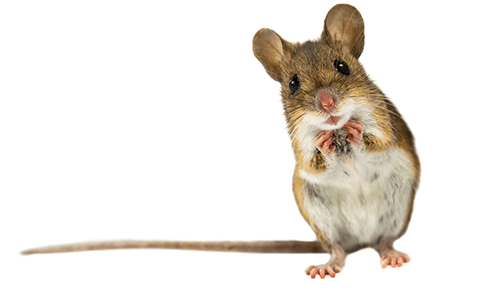by Rebecca Fyffe, ABC Humane Wildlife
As the weather turns cool this fall, we aren’t the only ones preparing for the frigid months ahead. Mice don’t want to be out in the elements either. In fact, it’s biologically adaptive as a reproductive strategy for them to find their way indoors. Mice that live outdoors have fewer offspring and smaller offspring than mice who are lucky enough to freeload in human occupied spaces.
Once mice are inside, it doesn’t take long for them to proliferate. Their short gestation period and large litter size means that a female mouse can produce a litter of 5-6 young every 18-21 days, and each of her daughters will be capable of bearing litters of her own at just 6-10 weeks old. This means that a mother mouse and her female offspring can produce a mouse infestation of over 2000 mice in just a year’s time! One doesn’t need to be a statistician to realize that early intervention is key when dealing with mice.
There are a number of do-it-yourself mouse control products on the market, such as traps, repellents, and ultrasonic devices, but unless the larger issue is addressed, these methods are a waste of money. While trapping mice may reduce the population slightly, it will not be swift or complete enough to make a meaningful difference when compared with mice’s prolific breeding. Ultra-sonic devices have been proven to be ineffective, because mice adapt quickly and ignore the sound they emit. There are only two methods of controlling mice that can truly make a meaningful difference in halting a mouse problem and preventing a new one from occurring: baiting and exclusion.
Mouse infestations in multi-unit properties are often first noticed when residents find telltale droppings in storage units or under sinks. Mouse stool looks like oblong black grains of rice, though they may turn gray with age.
It is an old adage in the pest control industry that there are 10 mice for every one you see. So when a mouse problem is reported, immediate response is key to arresting the problem. In multi-unit buildings, an infestation is rarely confined to a single apartment. A mouse will invade one unit, and the population will spread throughout the entire building. This means that it is impossible to eliminate a rodent problem without treating the structure as a whole. For some property managers, this will involve speaking with condo associations and convincing residents to allow a pest control company access to their homes. Getting everyone on board can be a serious challenge, but providing residents with extensive information regarding the dangers and damages associated with a rodent infestation can aid in this effort. Some pest control companies will even send certified pest management specialists to attend board meetings where they will be able to report on the status of the building and answer any questions the board members may have.
Mouse droppings and the fleas mice carry can spread disease. They have some other dirty habits too. Their foul-smelling urine can soak insulation and spaces within walls and ceilings. This can give a property a lingering musty smell that seems to come and go, but worsens when moisture and temperature levels change at the turn of seasons. Since each mouse can dribble 100 drops of acrid urine each day, controlling a problem swiftly is necessary to prevent this lingering musty smell from damaging the air quality and freshness of a site.
Integrated Pest Management (IPM) is the newer, greener way of managing mice and other pests in multi-unit properties. IPM establishes action thresholds for each species. An action threshold is the number of pest sightings it takes to warrant treatment. For instance, when it comes to spiders, ladybugs, or boxelder bugs, property managers should advise residents to wait and see if the problem becomes more significant before treating. The presence of these kinds of species most often falls under the category of occasional invaders, rather than full-scale infestation. Mouse invasion is just the opposite. The action threshold for treatment should begin with the report of a single mouse or their droppings. A maintenance plan should be put in place until entry points into the building have been identified and sealed to prevent further invasion; a hallmark of IPM called structural exclusion.
Mice can fit through gaps and holes the size of a dime. Structural exclusion involves identifying and sealing any holes that are dime-sized or larger with materials that keep rodents out. Expanding foam is not an acceptable sealant for rodent exclusion, as rodents can chew through it easily and sometimes seem to rather like it. Steel mesh and metal hardware cloth are better for this purpose and can be trimmed and formed around areas where pipes lead into buildings and other vulnerable gaps. The most common place that rodents enter is beneath doors and garage doors. Tight-fitting door-sweeps, preferably those containing metal or hard plastic edges rather than fiber bristles, are the most effective and economical method of structural exclusion that property managers can invest in to reduce rodent invasion. Installing dryer vent covers, crawl space vent covers, chimney caps, and trimming trees back 6 -8 feet from the roofline will reduce entry and damage by not just mice, but also squirrels.
Installing bait stations, hard metal or plastic boxes that house rodenticide bait, is the best way to remedy an infestation. A licensed pest control firm must perform this service because the baits are heavily regulated and their placement requires licensure and expertise. However, preventing a mouse infestation is a much better plan than treating an existing one because there is a nearly unavoidable and highly undesirable risk associated with treatment; a mouse or mice may sometimes die within walls or ceiling voids creating an unpalatable putrefactive odor and flies. This problem most often resolves by itself within a few days or weeks, but may sometimes require opening the wall to remove dead mice. If this happens, it is not your pest control provider’s fault. Luckily it is rare, but having mice die in the walls should be viewed as an unavoidable adverse consequence of rodent abatement. The best way to avoid this risk and hopefully avoid repeated rodent baiting all together is by employing structural exclusion.
Since rodents breed so quickly, timely baiting by pest control professionals should be arranged immediately before a problem worsens. Once baiting is underway, structural exclusion, sealing up any hole the size of a dime or larger, should reduce the need for baiting in the future. While mice may be tiny, the burden they impose on property managers is huge, since their ability to spread diseases and ruin structures with chewing and smelly urine makes them particularly undesirable pests. In summary, employing rodent bait stations right away at the first sign of mice, and most importantly, conducting extensive structural exclusion to reduce reliance on rodent baiting over time is the best two-pronged approach that property managers can utilize to maintain mouse-free facilities.
ABOUT THE AUTHOR: Rebecca Fyffe is a journalist and urban wildlife manager. Her firm, ABC Humane Wildlife & Pest Control Inc., in Arlington Heights, Ill., humanely manages urban wildlife and insects in the interest of human health and safety from an environmental sustainability perspective with a love of nature and a deep respect for all living things.






 Wayne Srsen
Wayne Srsen 

